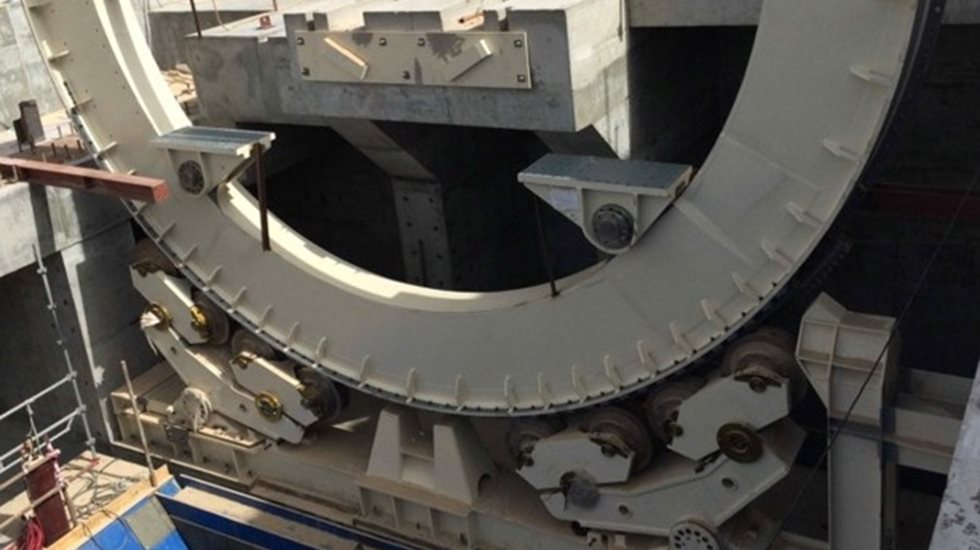
Effective Maintenance Practices for Railcar Dumper Trunnions
Your maintenance plan should always include a regular inspection of your railcar dumper trunnions. If you start to see any of the issues outlined in this article, it is critical to address them as quickly as possible before a major problem ensues.
The support trunnions are the foundation on which a car dumper is built. They frequently don’t get the attention they deserve as they operate in an often hard to reach and dirty environment but failure to do so could lead to bigger issues down the road.
Common Problems
WEAR
As the rollers and end ring rails wear, the dumper sits lower in the pit such that the platform / platen rails are no longer aligned to the corresponding land mounted rails. This leads to greater roll on and roll off loads of the rolling stock which generates undesired impact loads and stresses into the dumper cage. This can lead to premature failure of the trunnion bearings and development of fatigue cracks in the dumper structure.
Excessive wear on the thrust faces of the flanged rollers indicates that there is some misalignment and that the dumper cage is thrusting along the axis of the platform / platen rails. The end rings and end ring rails are experiencing equivalent thrust loads which can lead to cracking of the end rings and dumper cage as well as other problems.
ALIGNMENT / THRUSTING
The alignment can also change due to movement of the trunnion rollers, whether that be from a single incidence or gradually over time from rolling stock entering and leaving the dumper or foundation settlement. In such a scenario, the trunnions will no longer be parallel to each other leading to ‘corkscrewing’ of the dumper cage. Under these circumstances, the dumper cage wants to thrust in one direction or the other parallel to the track rails. This creates unwanted stresses in the cage that reduce the dumper operating life and increases wear on the trunnions and end ring rails. In severe cases, the dumper cage can thrust into the land mounted thrust pads with the potential for considerable damage.
Misalignment can also lead to problems at the pinion and gear rack as proper meshing of the teeth is no longer assured. The center distance can change such that the rack can potentially bottom out (or even come out of the mesh completely) and the contact area can be significantly reduced such that there is an overload. Ultimately, this will lead to premature wear of the pinion and rack and potentially tooth cracking or breakage.
LUBRICATION
Proper lubrication is important. Lack of lubrication leads to premature bearing failure and occasionally catastrophic damage. In many cases, the grease is not only a lubricant but is also a barrier seal to prevent dirt or material from getting into the bearing. Foreign material entering your bearings can damage them in a very short amount of time.
Too much lubrication builds pressure within the bearing. The increased friction and pressure from too much grease raises the temperature and can decrease the effectiveness of the lubricant. It can even cause the oil to separate from the thickener. This leads to decreased bearing life and consequently, a shorter period between major shutdowns.
Recommended Approach
INSPECTION
It’s good practice to set up a monthly inspection routine for your trunnions.
You should also continually be on the lookout for issues during normal operation (like excess spillage) and ask yourself the following questions:
- Is the dumper rotating/operating smoothly?
- Is the dumper operating within normal timeframes?
- Are there any new or unusual noises?
- Any new or unusual vibrations?
- Anything loose (e.g. connections / fasteners)?
- New wear marks or visible damage?
- Are the warning devices operating correctly?
INSPECTION TOOLS
There are a couple of simple tools, other than your standard tools, that can help you to take quick and accurate measurements of your trunnion wear:
- A steel diameter tape specific to the plain roller. This can be marked to identify the diameter at which the trunnion should be replaced.
- A profile gauge for both the plain and flanged roller. Measuring the gaps between the gauge and the roller gives you an easy measurement of wear. Again, this can be marked up to indicate when the roller should be replaced.
Metso Outotec can supply these tools together with allowable wear figures for most installations.
ALIGNMENT AND MECHANICAL AUDITS
- Perform regular alignments of your rotary car dumper. We recommend alignment and leveling of the dumper every 1-3 years dependent on the condition of the equipment and after every major equipment replacement.
- Alignment by an experienced technician with the correct tools and supporting calculations could pay future dividends in time and money.
- A mechanical audit assesses the condition of the trunnions (and the dumper as a whole) in order to help manage the maintenance budget and schedule.
REPLACEMENT
- Develop a replacement schedule for your dumper trunnions. Monitor the trunnion wear and replace parts before they pass the recommended wear limits. Refurbish parts where practical.
- Replacing the trunnions is not an easy job – it requires considerable downtime, equipment and manpower. You might want to consider upgrading to a more maintenance friendly and cost-effective trunnion design that allows quicker and easier removal of the trunnion wheels without the need for cranes or significant heavy lifting equipment. Metso Outotec offers a new trunnion design upgrade option.
Conclusion
Regular inspections and audits help the car dumper operator to budget for future service and equipment purchases and to plan their next maintenance shutdown. Proper inspections, assessments and maintenance provide vital data for the scheduling of new or replacement parts, upgrades and services.
Stay on top of your railcar dumper’s performance by following these simple suggestions
GET A CHECKLIST